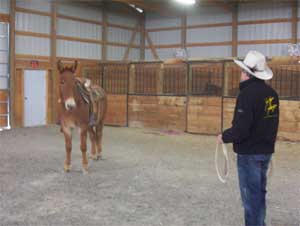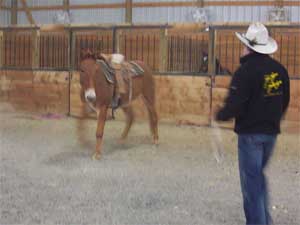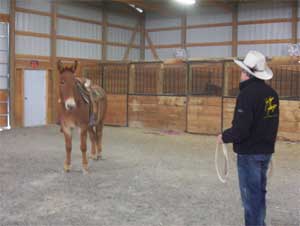We have all had it happen, the weather looks great and we decide
to saddle up our mule and go for a relaxing ride. After grabbing
the halter, we walk to the pasture gate only to see our mule
running off in the other direction.
Our relaxing afternoon just turned stressful. We now have to
spend our valuable riding time chasing our mule around the
pasture until our mule decides “I’ll let him catch me now.”
But what if you could teach your mule to catch you? By teaching
your mule the “Come To You” cue, you can.
Prerequisites to this lesson are basic round-penning exercises
including moving forward, the “Go Forward” cue, and inside and
outsides turns. Tools you will need are a lariat or whip and
boots for your mule to help protect his legs.
When teaching the “Come To You” lesson, the three things to
remember are:
- get your mule’s feet to move
- get your mule’s feet to move consistently
- and finally, get your mule’s feet to move in the direction you
want them to go.
As always, you will start by teaching the lesson on one side of
your mule, then teach the same lesson on the other side of your
mule. For this lesson, we will begin on the left.
Get Your Mule’s Feet to Move
With your mule loose in the round pen, ask your mule to walk
forward to the left by cueing the hip to move. To do this, you
will use your “Go Forward” cue in the same manner you have used
it previously while your mule was haltered or bridled: focus on
the hip and drive the hip forward with your lariat or whip. This
is the first step of the process, get your mule’s feet to move.
Get Your Mule’s
Feet to Move Consistently
|

Tim has asked Eugene to turn and face
him before progressing to the "Come to You" cue.
|
Next, you want to ask your mule to continue moving forward. This
is second step of the process, get your mule’s feet to move
consistently. After you ask your mule to “Go Forward,” he will
continue walking or trotting. If he stops, give the “Go Forward”
cue again, then immediately give a release. Continue this
pattern until your mule moves forward consistently. You must
allow your mule to stop in order for him to understand the cue
to continue moving.
Now that your mule is moving forward consistently, you are going
to begin asking your mule to move his feet in the direction you
want them to go, which is the third step of the process. We are
going to begin by asking for inside turns.
Inside turns are essential to the “Come To You” cue. Your mule
is moving consistently around the round-pen to the left. When
you are ready to ask for an inside turn, follow these steps:
back up and kiss or cluck to your mule (this will open the door
for your mule to turn inside). Once your mule begins to turn
inside from the left, begin moving in the direction your mule
WAS going (to the left and drive your mule’s other hip forward
and to the right). Once your mule is moving consistently to the
right, release the cue to move forward. After your mule takes
several (10, 11, 12) steps to the right, repeat the process back
to the left, and so on several hundred times. Now you have your
mule moving his feet in the direction you want them to go.
Remember, you don’t have to finish an exercise in one day. Take
several days to teach your mule inside turns.
Get Your Mule’s Feet to Move Consistently
In The Direction You Want Them To Go
The next step is asking your mule to turn and face you in the
round pen. To ask your mule to turn toward the center of the
round-pen and face you, ask him to go forward consistently, then
back up as if you are asking for an inside turn, then stop. Do
not drive the hip in the other direction. When you stop, you are
telling your mule that he is also allowed to stop and wait for
the next cue.
After your mule has stopped and is facing you, walk up to your
mule and praise him. This is the next step in teaching him to
come to you. Now, walk back to the center of the round-pen.
Next, send your mule off to the left and ask for several inside
turns, but no more than 10. Ask your mule to turn and face you
again. When he does, go up and praise him. Repeat this process
until your mule is 100 percent consistent at turning and facing
you. Once your mule is consistent, begin asking him to take a
step towards you after he turns and faces you. Ask by taking one
or two steps to your right and kissing or clucking to your mule.
Stepping off-center of your mule will set him slightly off
balance and he will need to shift his weight. Kissing or
clucking will encourage the shift in weight and take a step in
your direction to re-balance. Praise him!
|

After several hundred repetitions, Tim
begins asking Eugene to take steps towards him.
|
Continue praising him for every step he takes towards you.
Remember, we are initially looking for just one step. We will
build on that.
You are always looking for your mule to improve, even minimally.
Your mule may initially take a step to the side before he begins
walking towards you. This is okay; he is trying to figure out
what answer you are looking for. Praise him but be sure you
praise him for making an attempt at moving towards you. If he
does not move or make an attempt to respond to your cue, send
him back out and do several more inside turns.
To continue the lesson, be sure your mule is consistent with one
step, then ask for two, three, four, etc., until he is standing
in front of you. Remember, give your mule a chance to respond to
your cue, but do not ask three or four times before he responds.
Give your mule a chance. If he does not respond by making an
attempt to move “something” in your direction when you cue him,
send him off.
Now that your mule is coming to you on cue – your kiss or cluck
– begin moving yourself to different spots in the round pen and
ask him to come to you from a stand-still position. Praise him
when he does; send him off if he does not.
|

After much practice, Eugene
understands the "Come to You" cue that Tim has given. By
kissing or clucking, Tim can ask Eugene to catch him
instead of Tim catching Eugene. |
You can advance the lesson by taking your mule to another small
enclosed area and working on the “Come To You” cue there. Try a
corral or small fenced in arena.
Another way to advance the lesson is to ask your mule to trot or
canter to you. Follow the same steps you did for the walk, just
keep your mule trotting or cantering around the round-pen
consistently before asking for the turn, face and step.
Eventually he will begin taking a trot step towards you. Be sure
you ask at the trot before you ask at the canter.
Now, when that nice day comes around and you want to take a
ride, you can walk to the pasture and cue your mule to “Come To
You” and he will come running! Enjoy your ride.
Tim can be reached at
www.diamondcreekmules.com, or by phone at 307/899-1089, or
email:
bliss@wavecom.net.
Also, check out our website (Training Page) in November and
December for “Training Shorts,” Tim’s short training
demonstration videos.
Finally, Tim is now scheduling mule clinics for January thru
April. If you are interested in hosting a clinic in your area,
book now by calling Tim at 307-899-1089.
|